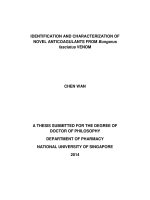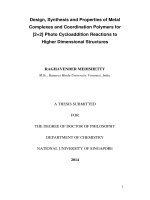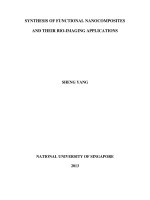Novel functional 1d and 2d conjugated polymers design, synthesis and characterization
Bạn đang xem bản rút gọn của tài liệu. Xem và tải ngay bản đầy đủ của tài liệu tại đây (6.74 MB, 259 trang )
NOVEL FUNCTIONAL 1D AND 2D CONJUGATED
POLYMERS: DESIGN, SYNTHESIS AND
CHARACTERIZATION
LI HAIRONG
NATIONAL UNIVERSITY OF SINGAPORE
2008
NOVEL FUNCTIONAL 1D AND 2D CONJUGATED
POLYMERS: DESIGN, SYNTHESIS AND
CHARACTERIZATION
LI HAIRONG
(M. Sc. Singapore-MIT Alliance, NUS, Singapore.
B. Eng. Zhejiang University, PRC)
A THESIS SUBMITTED
FOR THE DEGREE OF DOCTOR OF PHILOSOPHY
DEPARTMENT OF CHEMISTRY
NATIONAL UNIVERSITY OF SINGAPORE
2008
NAME: LI HAIRONG
DEGREE: DOCTOR OF PHILOSOPHY
DEPARTMENT: CHEMISTRY
THESIS TITLE: NOVEL FUNCTIONAL 1D AND 2D CONJUGATED
POLYMERS: DESIGN, SYNTHESIS AND CHARACTERIZATION
A
A
b
b
s
s
t
t
r
r
a
a
c
c
t
t
Design and characterization of novel conjugated polymers are of great importance
in understanding the intrinsic properties to realize the practical applications in many
aspects. Among the various conjugated polymers, poly(p-phenylene)s (PPPs) and its
derivatives are of considerable interests due to their solvent tractability, high thermal
and chemical stabilities, high quantum yield and versatile synthetic strategies. Our
efforts focused on investigating the structure-property relations of rationally designed
PPPs, seeking the potential sensor and biological applications of water soluble PPPs.
Continuous endeavor to chemical modification of PPPs involved an introduction of
conjugated side chain onto PPP backbone, with specific highlights of crystalline
nature, aggregation phenomenon, unique photophysical and self-assembly properties
arisen from extended conjugation and strong π-π interaction. Structure-property
relations were further explored in cross-conjugated cruciform system and preliminary
work was carried out on cross conjugated polyphenols for antioxidant and toxicity
studies.
Keywords: poly(p-phenylene), water soluble, biomineralization, cross-conjugated,
sensor, photophysical properties, self-assembly, aggregation, crystal, cruciform,
polyphenol, antioxidant, toxicity.
ACKNOWLEDGEMENTS
I am deeply grateful to a lot of people, who have supported this work by different
means.
Above all, I would like to express my sincere gratitude to my supervisor Prof.
Suresh Valiyaveettil and co-supervisor Prof. Lim Chwee Teck for their constructive
guidance, full support and constant encouragement.
I sincerely thank all the current and former members of the group for their
cordiality and friendship. I thank Akhila, Balaji, Colin, Elena, Hairyu, Gayathri,
Jegadesan, Renu, Santosh, Sindhu, Sivamurugan, Shaowen, Sheeja, Shirley and Yean
Nee for all the good times in the lab and helping exchange knowledge skills. I am
grateful to Dr. Vetrichelvan for his sincere guidance and help in the beginning of my
research. I also appreciate the assistance from Nurmawati in OM, TEM, SEM and
Fathima in XRD, Nanofiber fabrication.
Technical assistance provided by the staffs of the various laboratories at the
Faculty of Science is gratefully acknowledged.
I thank National University of Singapore Nanoscience and Nanotechnology
Initiative for scholarship. Financial supports from Agency for Science and Technology
Research and National University of Singapore are also acknowledged.
Words cannot express my deepest gratitude to my beloved parents and
grandparents. I wholeheartedly thank them for their understanding, moral support and
encouragement.
i
TABLE OF CONTENTS
Acknowledgments
i
Table of contents
ii
Summary
vii
Abbreviations and Symbols
x
List of Tables
xiv
List of Figures
xvii
List of Schemes
xxiii
1 Linear and Cross Conjugated Poly(p-
phenylenes) and Oligo(p-phenylenes)
Introduction
1
1.1 Conjugated polymers What and Why?
2
1.2 Conjugated polymers An overview
3
1.3 Poly(para-pheneylenes) (PPPs) An important class of CPs
4
1.3.1 Overview of PPPs 4
1.3.2 Synthetic strategies of PPP and derivatives 5
1.3.3 Important photophysical properties Brief
introduction
10
1.3.3.1 Absorption and emission 10
1.3.3.2
Fluorescence lifetimes and quantum yields 12
1.3.3.3 Two photon absorption 14
1.3.4 Photophysical properties of typical PPPs 15
1.3.4.1 Linear PPPs 15
1.3.4.2 Cross conjugated macromolecules 33
ii
1.4 Scope and outline of the thesis
55
1.5 References
57
2 Synthesis and Comparison of Structure-
Property Relationship of Symmetric and
Asymmteric Water Soluble Poly (para-
phenylenes)
68
2.1 Introduction
69
2.2 Experimental
70
2.2.1
Measurements
70
2.2.2 Synthesis 71
2.3 Results and discussion
75
2.3.1 Characterization of polymers 75
2.3.2. Thermal properties 76
2.3.3. Optical properties 76
2.3.4. Aggregation properties of polymers 78
2.3.5. Complexation studies 85
2.3.6. Packing structure in solid state 90
2.3.7. Polymer as template for controlled biomineralization
mimics
92
2.4 Conclusion
97
2.5 References
97
iii
3 Water Soluble Multifunctional Cross
Conjugated Poly(para-phenylenes) as Stimuli
Responsive Materials: Design, Synthesis, and
Characterization
100
3.1 Introduction
101
3.2 Experimental
102
3.2.1 Measurements 102
3.2.2 Synthesis 103
3.3 Results and discussion
109
3.3.1. Characterization 109
3.3.2. Thermal properities 110
3.3.3. Absorption and emission spectra 111
3.3.4. Titration studies 112
3.3.5 Aggregation properties 122
3.3.6. Thin film and nanofiber 124
3.4 References
126
3.5 Conclusion
127
4 Synthesis and Structure-Property
Investigation of Novel Poly(p-phenylenes) with
Conjugated Side Chain
130
4.1 Introduction
131
4.2 Experimental
132
4.3 Synthesis
133
4.4 Results and discussion
138
iv
4.4.1 Characterization 138
4.4.2 Powder X-ray diffraction 139
4.4.3 Absorption and emission 140
4.4.4 Quantum yield and two photon absorption (TPA) 146
4.4.5. Time-correlated single-photon counting 147
4.4.6. Solid phase self-assembly and morphology 150
4.5 Conclusion
152
4.6 References
153
5 Synthesis and Characterization of Cross
Conjugated Cruciforms with Varied
Functional Groups
160
5.1 Introduction
161
5.2 Experimental
162
5.2.1 Synthesis 162
5.2.2 Characterization 165
5.3 Results and discussion
170
5.3.1. Thermal properties 170
5.3.2. Absorption and emission properties 170
5.3.3 X-ray diffraction studies 172
5.3.3.1 Powder XRD studies 172
5.3.3.2 Single crystal XRD studies 174
5.3.4 Liquid crystal study 175
5.4 Conclusion
176
v
5.5 References
177
5.6 Appendix
179
6 Synthesis and Characterization of Cross
Conjugated Polyphenols
185
6.1 Introduction
186
6.2 Experimental
188
6.3 Results and discussion
190
6.3.1 Synthesis 190
6.3.2 Characterization 200
6.3.3 Absorption and emission properties 201
6.3.4 Antioxidant properties 204
6.3.5 Bioactivity studies 207
6.4 Conclusion
213
6.5 References
213
7 Design, Synthesis and Characterization of
Pyrene Derivatives with Conjugated Arms
216
7.1 Introduction
217
7.2 Synthesis and characterization
220
7.3 UV-Vis absorption and emission studies
224
6.4 Conclusion
229
6.5 References
229
List of publications
232
vi
S
S
u
u
m
m
m
m
a
a
r
r
y
y
Chapter 1 is a literature review on history and recent development of conjugated
macromolecules, with major efforts on linear poly(para-phenylenes) and cross-conjugated
polymers and cruciforms.
My research work started from the structure-property comparison of two sets of
symmetrical and asymmetrical sulfonate water soluble poly(p-phenylenes) (PPPs)
(Chapter 2). The polymers aggregated in water/tetrahydrofuran (THF) mixture through
microphase separation of polar (water) and nonpolar (THF) groups into appropriate
solvents and strong intermolecular interactions. The fluorescence of the polymers was
quenched in the presence of analytes including viologen derivatives, cytochrome-C (Cyt-C)
and metal ions in water with Stern-Volmer constant in order of 10
6
M
-1
, indicating the
potential application in sensors. Light-emitting iso-oriented calcite crystals were
synthesized by controlled crystallization in presence of the water soluble PPPs. The nature
of the functional groups on the polymer backbone and their ordered pack played a crucial
role for the selective morphogenesis of the crystals with controlled particle shape, size and
orientation.
The polymers in Chapter 2 had only one acceptor, which limited their versatility.
Therefore, further efforts were made towards water soluble cross-conjugated PPPs
(Chapter 3). Polymers with two different acceptors and extended conjugation in two-
dimensions were able to respond to different kinds of analytes in trace amount via
fluorescence quenching combined with a blue or red shift of UV-Vis absorption maximum
vii
depending on structure of the polymers and quenchers. All polymers were able to form
smooth, flexible and uniform thin films with strong blue fluorescence. Aligned nanofibers
were also made successfully, thanks to the strong intermolecular electrostatic and π-π
interactions. These results provided a novel way to extend the capability in chemo- and
bio-sensor applications.
It was found that the polymers in Chapter 3 had strong aggregation in aqueous
solution, driven by electrostatic, hydrophobic-hydrophobic and π-π interactions. We were
interested in eliciting some information on how the π-π interaction affected the properties
of the polymers. Hence in Chapter 4, a series of organo-soluble cross-conjugated
polymers were designed and synthesized. Absorption, excitation and emission results
indicated a highly concentration dependent relationship due to strong intermolecular
energy transfer. Large two photon absorption cross sections were derived from the
extended conjugation along side chains and aligned “push-push” and “push-pull” structure.
Extended conjugation and strong intermolecular interaction were further confirmed by
time-correlated single-photon counting. Because of their unique structures, interesting
self-assembly properties were discovered simply by drop casting.
Since we had confirmed the extended π-electron delocalization existing in cross-
conjugated PPPs in Chapter 4, it was necessary to understand how the different kinds of
conjugated segment contributed to the overall properties, therefore we shift to new target
with well-defined structures call cross-conjugated cruciform. A series of cross conjugated
cruciforms with varied functional groups substituted at two different segments were
discussed in Chapter 5. It was concluded that the photophysical properties were highly
influenced by the extent to which conjugated segment participated in conjugation. Strong
viii
π-π interaction and ordered packing were confirmed by single crystal X-ray diffraction
(XRD). Liquid crystal behavior was observed for some cruciforms, which was originated
from strong intermolecular interaction between mesogenic cores and coordination of
flexible alkyl chains.
In Chapter 6, a novel class of cross conjugated polyphenols was synthesized and
characterized. The design of the molecules was targeted at achieving a high antioxidant
property by varying the number of hydroxyl groups on the numbers and the length of the
linear conjugation. Trolox equivalent antioxidant capacity (TEAC) assay has revealed that
more extended conjugation and larger number of phenolic hydroxyl groups contributed to
higher antioxidant property via lowering the dissociation energy of the phenolic O-H bond
and increasing the stability of resulting phenolate radicals.
In Chapter 7, pyrene derivatives with conjugated segment were reported, unlike the
previous chapters, we’d like to extend the core size and investigate the effect of
conjugation. Absorption and emissions studies were performed and comparisons made
amongst them and their precursors and the cruciforms reported in Chapter 5. It was noted
that all compounds had absorption and emission maxima in the range of 426-488 nm and
508-541 nm respectively. The HOMO-LUMO energy gap of the derivatives is in the range
of 2.30-2.58 eV. However, the band gap tuning was largely limited on 2, 5, 7, 10-
positions due to meta-link. Therefore, the photophysical properties of pyrene derivatives
were limited by less effective conjugation between segments, unlike the cruciforms in
Chapter 5 & 6 where the conjugation was limited by highly twisted para-phenylene
segment.
ix
ABBREVIATIONS AND SYMBOLS
1D One Dimensional
2D Two Dimensional
3D Three Dimensional
1
H-NMR Proton Nuclear Magnetic Resonance
13
C-NMR Carbon Nuclear Magnetic Resonance
Å Anstrom(s)
δ
Chemical shift (in NMR spectroscopy)
Φ Fluorescence quantum yield
τ
Measured fluorescence lifetime
τ
nrad
Non-radiative lifetime
Γ
Rate constant for fluorescence decay
τ
rad
Radiative lifetime
λ
Wavelength
θ Diffraction angle
ca.
About
AFM Atomic Force Microscopy
b Broad
BuLi Butyllithium
CHCl
3
Chloroform
CLSM Confocal Laser Scanning Microscope
conc.
Concentrated
CV Cyclic Voltammetry
CP Conjugated Polymer
x
d Doublet
dd Double of Doublet
DCM Dichloromethane
DLS Dynamic Light Scattering
DP Degree of Polymerization
DMF Dimethylformamide
DMSO Dimethylsulfide
D
2
O Deuterium Oxide
EA Ethyl Acetate; Elemental Analysis
EI-MS Electron Impact Mass Spectrum
ESIPT Excited State Intramolecular Proton Transfer
EtOH Ethanol
FS Femtosecond
GPC Gel Permeation Chromatography
HBC Hexa-peri-hexaBenzoCoronene
Hz Hertz
FT-IR Infrared Fourier Transform
hr Hour(s)
i.e. That is (Latin id est)
J Coupling constant
KBr Potassium Bromide
K
2
CO
3
Potassium Carbonate
K
sv
Stern-Volmer constant
LED Light Emitting Diode
xi
LB Langmuir-Blodgett
m Multiplet
m/z Mass/Charge
MeOH Methanol
mg Milligram(s)
mN/m milliNewton/meter
mL Milliliter(s)
mmol Millimol
MW Molecular Weight
NBS N-bromosuccinimide
nm nanometer
OBn O-Benzyloxy
OM Optical Microscope
OPA One Photon Absorption
OPP Oligo(para-phenylene)
PA Polyacetylene
PANI Polyaniline
Pd(0)P(Ph
3
)
4
Tetrakis(triphenylphosphine)Palladium(0)
Pd/C Palladium on Carbon
PDI PolyDispersity Index
PF Polyfluorene
PL Photoluminescence
PPE Polyphenyleneacetylene
PPP Poly(p-phenylene)
xii
PPS Poly(phenylene sulphide)
PPV Polyphenylenevinylene
PPY Polypyrrole
PT Polythiophene
ps Picosecond
QY Quantum Yield
q Quartet
ROS Reactive Oxygen Species
RT Room Temperature
s Singlet; Second
SEM Scanning Electronic Microscope
t Triplet
t
t
Transit time
TCSPC Time-Correlated Single-Photon Counting
TEAC Trolox Equivalent Antioxidant Capacity
TEM Transmission Electron Microscope
TGA Thermo Gravimetric Analyzer
TMS Tetramethylsilane
THF Tetrahydrofuran
TLC Thin Layer Chromatogharphy
TPA Two Photon Absorption
UV-Vis Ultra-Violet Visible spectroscopy
WSP Water Soluble Polymer
XRD X-Ray Diffraction
xiii
Table No.
LIST OF TABLES
Page
No.
Chapter 1
Table 1.1
Representative linear PPPs 16
Table 1.2
Representative cross conjugated molecules 34
Chapter 2
Table 2.1
Absorption and emission wavelength for the polymers P1-P5 in
water
77
Table 2.2
Stern-Volmer constants for the polymers upon addition of the
quencher
89
Chapter 3
Table 3.1
GPC, TGA, UV-Vis absorption and emission maxima of P1-P6 111
Table 3.2
Stern-Volmer constant K
sv
for P1-P6 with titration of five
quenchers in water
121
Table 3.3
Changes in emission maxima in presence of added quenchers in
water
121
Table 3.4
K
sv
for P1-P6 with titration of five quenchers in 20 mM NaCl
solution
123
Table 3.5
K
sv
for P1-P6 with titration of five quenchers in 100 mM NaCl
solution
123
Chapter 4
xiv
Table 4.1
Molecular weight and TG value of P1-P5 139
Table 4.2
Absorption maxima of the polymers in THF, fluorescence maxima
at low (P
L
), high (P
H
) concentrations in THF, thin film (P
N
) and
excitation maxima (P
E
)
141
Table 4.3
Absorption maxima of the polymers in toluene, fluorescence peaks
at low (P
L
,), high (P
H
,) concentrations in toluene and excitation
maxima (P
E
)
144
Table 4.4
Quantum yield, absolute and relative values of TPA cross section
for P1-P5 in THF and toluene, polarity index is given in
parenthesis, rhodamine B was the standard
147
Table 4.5
Life time (τ) and amplitude (a) for emission decay at concentration
of 10
-7
M
148
Chapter 5
Table 5.1
TGA results of O1-O10 (°C) 170
Table 5.2.
Table 5.2. UV-Vis absorption and fluorescence properties of O1-
O10
171
Table 5.3
Crystal data and structure refinement for O5 179
Table 5.4
Atomic coordinates ( x 10
4
) and equivalent isotropic displacement
parameters (Å
2
x 10
3
) for O5. U(eq) is defined as one third of the
trace of the orthogonalized U
ij
tensor
180
Table 5.5
Bond lengths [Å] and angles [°] for O5 181
Table 5.6
Anisotropic displacement parameters (Å
2
x 10
3
) for O5 183
Table 5.7
Hydrogen coordinates ( x 10
4
) and isotropic displacement
parameters (Å
2
x 10
3
) for O5
184
xv
Chapter 6
Table 6.1
Absorption and emission maxima of 8b – e, 9b – e, 10b – e, 1b –
e, 2b – e in THF (nm)
203
Table 6.2
TEAC values of the synthesized compounds and typical
antioxidants
206
Chapter 7
Table 7.1
Summary of absorption and emission peak maxima and calculated
band gap
225
xvi
Figure No. LIST OF FIGURES
Page
No.
Chapter 1
Figure 1.1
Chemical structures of some of the typical conjugated polymers. 2
Figure 1.2
Chemical structure of unsubstituted PPP. 5
Figure 1.3
Representative ladder-type PPP structures. 8
Figure 1.4
Energetic processes on absorption of a photon in the Jablonski
diagram.
10
Chapter 2
Figure 2.1
Molecular structure of the polymers. 73
Figure 2.2
Absorption (A) and fluorescence (B) spectra of polymers P1 –
P5 in water.
77
Figure 2.3
(A) UV-Vis spectra and plot of absorption maxima v.s. THF
concentration (inset) for polymer P1 in water and water/THF
mixtures; (B) The fluorescence spectra of polymer P1 in water
and water/THF mixtures.
80
Figure 2.4
Changes in the emission spectra of P2 at different water/THF
mixtures. Inset: The emission intensity of P2 with the % of
THF.
80
Figure 2.5
Changes in the UV-Vis spectra of P5 at different water/THF
mixtures. Inset: Absorption maxima of P5 versus the % of THF.
81
Figure 2.6
Changes in the emission spectra of P5 at different water/THF
mixtures. Inset: The emission intensity of P5 with the % of THF.
82
Figure 2.7
The hydrodynamic diameter (D
h
) profile obtained from DLS
studies for the polymer P1 in 100 % water (A), 25 % THF (B),
50 % THF (C) and 75 % THF (D)
82
xvii
Figure 2.8
AFM of polymer P1 in 100 % water (left) and in 25 % THF
(right).
83
Figure 2.9
Cartoon representing the aggregation of polymers by the
addition of tetrahydrofuran to a water solution).
84
Figure 2.10
Changes in the emission spectra of P1 (A, C, E) and P5 (B, D,
F) in water at different concentrations of viologens.
87
Figure 2.11
Stern – Volmer plots of the polymer P1 and P5 quenched by the
viologen derivatives.
88
Figure 2.12
Changes in the emission spectra of P1(A) and P5 (B) in water at
different concentrations of cytochrome-C.
88
Figure 2.13
(A) XRD power patterns of the polymers P1-P5. A cartoon
representing a solid-state packing model of the polymers of P1-
P3 (B) and P4-P5 (C).
91
Figure 2.14
SEM and CLSM image of the CaCO
3
crystals grown in the
presence of P1 (1mg/mL); XRD patterns of the calcite crystals
grown in presence of 1 mg/mL of P1; Schematic representation
of a possible binding of P1 with Ca
2+
ions in the crystallization
medium for the formation of oriented calcite crystals; a unit of
{104} plane of the calcite crystal lattice is also shown.
94
Figure 2.15
XRD patterns of the calcite crystals grown in presence of 1
mg/mL of P1 (a) and in the absence of polymer (b). Inset shows
the electron micrographs of the representative crystals.
96
Figure 2.16
SEM images of CaCO
3
grown on a glass substrate, in presence
of P2, with concentrations of 100 μg/mL (a), 500 μg/mL (b) and
1 mg/mL (c). XRD pattern of the crystals and composites
formed in presence of P2 for different concentrations (d).
Representative CLSM image shows the fluorescent nature of the
calcium carbonate polymer composite formed (e).
96
Chapter 3
Figure 3.1
A cartoonistic representation of various pathways for electronic 101
xviii
conjugations in 2D polymers, X and Y represent donor-acceptor
type functional groups.
Figure 3.2
Molecular structures of target polymers. 102
Figure 3.3
Normalized absorption (A) and emission (B) spectra of P1 (■),
P2 (●), P3 (▲), P4 (□), P5 (○) and P6 (△) in water (20 mg/L).
111
Figure 3.4
Fluorescence spectra of P1 with titration of five different
quenchers in water solution with concentration of 20 mg/L.
Direction of intensity changes is indicated by the arrow.
Quencher concentrations are indicated in each figure and
parenthesis.
116
Figure 3.5
Fluorescence spectra of P2 with titration of five different
quenchers in water solution with concentration of 20 mg/L.
Direction of intensity changes is indicated by the arrow.
Quencher concentrations are indicated in each figure and
parenthesis.
117
Figure 3.6
Fluorescence spectra of P3 with titration of five different
quenchers in water solution with concentration of 20 mg/L.
Direction of intensity changes is indicated by the arrow.
Quencher concentrations are indicated in each figure and
parenthesis.
118
Figure 3.7
Fluorescence spectra of P4 with titration of five different
quenchers in water solution with concentration of 20 mg/L.
Direction of intensity changes is indicated by the arrow.
Quencher concentrations are indicated in each figure and
parenthesis.
119
Figure 3.8
Fluorescence spectra of P5 and P6 with titration five different
quenchers in water solution with concentration of 20 mg/L.
Direction of intensity changes is indicated by the arrow.
Quencher concentrations are indicated in each figure and
parenthesis.
120
Figure 3.9
Titration curves of P1 (○), P2 (●), P3 (▲), P4 (□) and P6 (■)
(F) in presence of potassium hexacyanoferrate(III). Polymer
concentration was 20 mg/L.
121
Figure 3.10
(A) Hydrodynamic diameter profile obtained from DLS for P2
with titration of 9,10-anthraquinone-2,6-disulfonic acid
124
xix
disodium salt (AD) in water. (B) UV-Vis absorption spectra of
P2 with titration of AD in water. Direction of peak shift is
indicated by the arrow. Polymer concentration was 20 mg/L.
Figure 3.11
SEM micrograph of the thin film (A) indicating the thickness of
the film (B), confocal and optical (inset) micrographs of thin
films of P1 prepared from a water solution with a concentration
of 10mg/mL on a glass plate (C), SEM and confocal (inset)
micrographs of nanofibers made from P1 with 5% vinyl alcohol
as cross-linker.
125
Chapter 4
Figure 4.1
Chemical structures of five polymers.
132
Figure 4.2
Left: Powder XRD spectra for P1 to P5; Right: schematic
diagrams of possible packing structures for P2 (a, double
degeneracy) and P3 (b, c).
140
Figure 4.3
Normalized absorption (a) and emission at a low concentration
in THF (0.002 g/L) (b), emission at high concentration in THF
(0.2 g/L) (c), and emission of spin coated thin film (d), for P1-
P5; Excitation spectra (EX) of P1-P5 monitored at the emission
peaks at a low concentration.
142
Figure 4.4
Normalized absorption (a) and emission at a low concentration
in toluene (0.002 g/L) (b), emission at high concentration in
toluene (0.2 g/L) (c), for P1-P5; Excitation spectra (EX) of P1-
P5 monitored at the emission peaks at a low concentration.
145
Figure 4.5
Fluorescence decay curves of P1-P5 in THF monitored at 450
nm (10
-7
M ■; 10
-5
M □).
149
Figure 4.6
SEM images of P1 drop-casted from solutions of different
concentrations onto glass plate: 0.5 mg/mL (A); 0.2 mg/mL (B);
0.05 mg/mL (C). Schematic view of the hierarchical self-
assembly of P1 into left-helix supramolecular structures (D).
151
Figure 4.7
HRTEM images and electron diffraction patterns at crystalline
domains of P3 thin film.
152
xx
Chapter 5
Figure 5.1
Molecular structures of the target compounds. 161
Figure 5.2
Normalized absorption spectra for O1-O10, recorded in THF
solution at concentration of 10 mg/L.
172
Figure 5.3
Normalized emission spectra for O1-O10, recorded in THF
solution at concentration of 10 mg/L.
172
Figure 5.4
Powder XRD results of O1-O10. 173
Figure 5.5
Molecular structure and packing of O5 solved by single crystal
XRD.
174
Figure 5.6
POM graph of the textures observed on cooling of O2 (up) and
O3 (mid) at a cooling rate of 0.5 °C /min and DSC spectra
(bottom).
175
Chapter 6
Figure 6.1
Synthesized cross conjugated polyphenols. 187
Figure 6.2
Normalized absorption spectra of 8b – e, 9b – e, 10b – e, 1b – e,
2b – e in THF.
202
Figure 6.3
Normalized emmision spectra of 8b – e, 9b – e, 10b – e, 1b – e,
2b – e in THF.
203
Figure 6.4
(A) The differential interphase contrast (DIC) images of control
cells IMR-90, (B) treated cells (IMR-90) which showed irregular
cell morphology due to cell death (C), Control cells (U251) and
(D) treated cells (U251).
208
Figure 6.5
The effect of the chemicals on U251 and IMR-90 expressed as
% of viable cells after the treatment. At higher concentrations of
the polyphenol a drop in viability was observed. X axis
represents the cell line and polyphenol employed. Y-axis
represents % of viable cells. Legends indicate the concentration
209
xxi
of polymer used.
Figure 6.6
The effect of polyphenols in controlling the mitochondrial
activity inside the cells. X axis represents the cell line and
polyphenol employed. Y-axis represents % of metabolically
active cells. Legends indicate the concentration of polyphenol
used.
209
Figure 6.7
Cytotoxicity of the polyphenols on different cells in terms of
their potency to result in cell lysis. X axis represents the cell line
and polyphenol employed. Y-axis represents % of release of
LDH as calculated form the cell culture supernantent. Legends
indicate the concentration of polyphenol used. A concentration
dependant increase in LDH leakage was observed which
indicates cell membrane damage.
210
Figure 6.8
(A) The cancer cells without any polyphenol added, (B) control
cells, IMR-90 without any polyphenol (C) and (D) 2c treated
cancer cells and fibroblasts respectively; (E) and (F) represents
2d treated cancer cells and normal cells respectively. (G) and
(H) represents 2b treated cells cancer cells and normal cells
respectively. The % of cells is indicated with each histogram.
The cells are treated with a fixed concentration of the
polyphenol, 60 μg/ml for the analysis.
212
Figure 6.9
Graphical representation of % of cells in different phases of cells
cycle, subG
1
represents percentage cells as indicated by M1
marker in histogram (Figure 6.8); similarly G1 represents M2; S
represents M3; G2/M represents M4.
212
Chapter 7
Figure 7.1
Structure and labeled positions of pyrene. 218
Figure 7.2
UV-Vis absorption (left) and emission (right) of pyrene (T0),
T1, T2, T3 and precursors 7 and 8.
224
Figure 7.3
Molecular structures of cruciform O1-O10 reported in Chapter
5.
225
xxii









